Analyzing Psychological Aspects of 'A Beautiful Mind' Movie
VerifiedAdded on 2022/12/23
|9
|2619
|42
Essay
AI Summary
This essay offers a comprehensive psychological overview of the film 'A Beautiful Mind,' focusing on the character of John Nash and his experiences with paranoid schizophrenia. The analysis delves into the portrayal of his hallucinations, delusions, and the progression of his mental illness, highlighting the impact on his social life, relationships, and genius-level intellect. The essay explores the factors contributing to his condition, including feelings of superiority, fear, and the pressure to succeed, and examines the movie's depiction of his treatment and eventual management of the illness. The role of family support, self-awareness, and acceptance are discussed as crucial elements in his journey. The essay also touches upon the movie's educational value in understanding mental disorders and the potential for intervention and recovery, emphasizing the challenges and societal impacts of mental health issues.
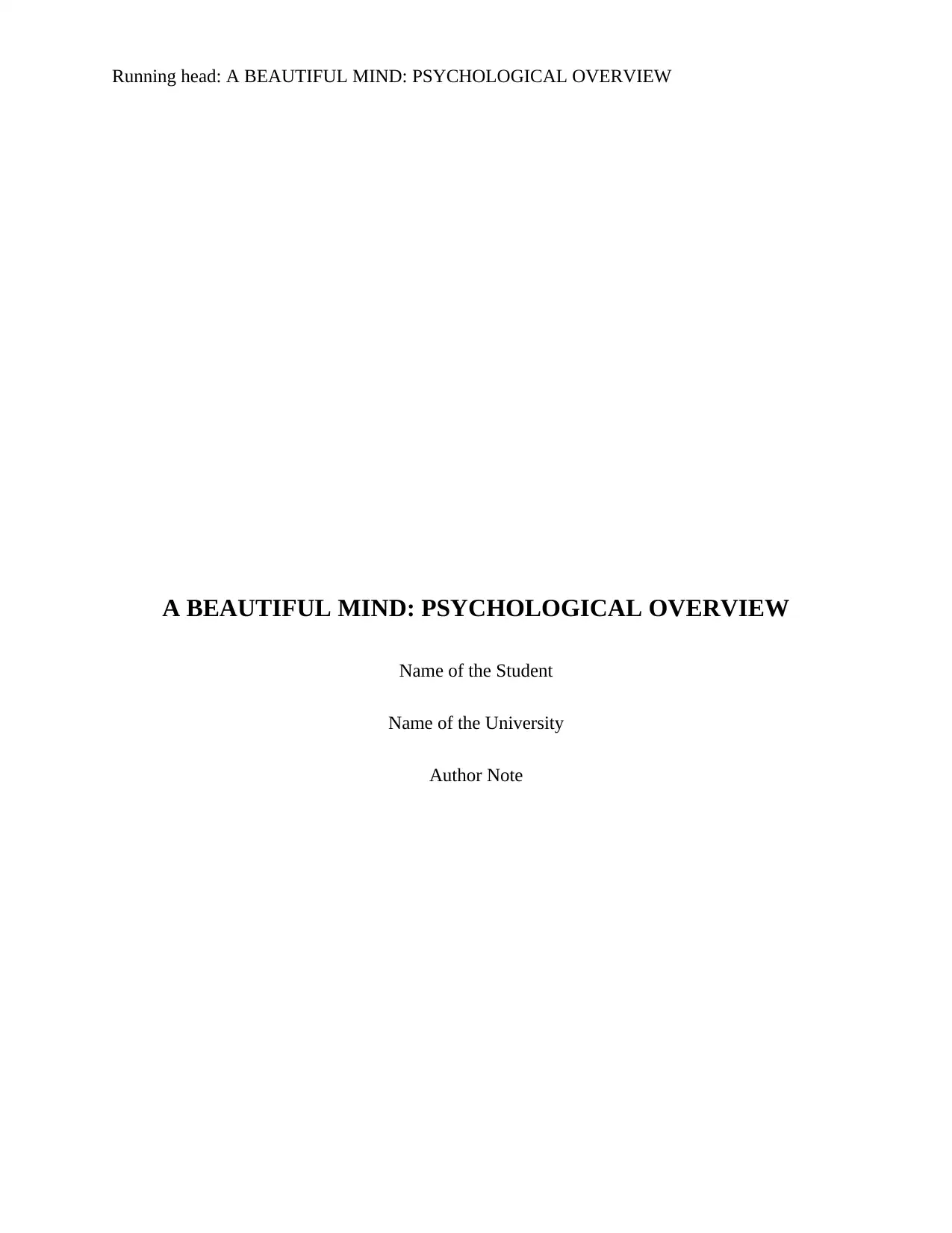
Running head: A BEAUTIFUL MIND: PSYCHOLOGICAL OVERVIEW
A BEAUTIFUL MIND: PSYCHOLOGICAL OVERVIEW
Name of the Student
Name of the University
Author Note
A BEAUTIFUL MIND: PSYCHOLOGICAL OVERVIEW
Name of the Student
Name of the University
Author Note
Paraphrase This Document
Need a fresh take? Get an instant paraphrase of this document with our AI Paraphraser
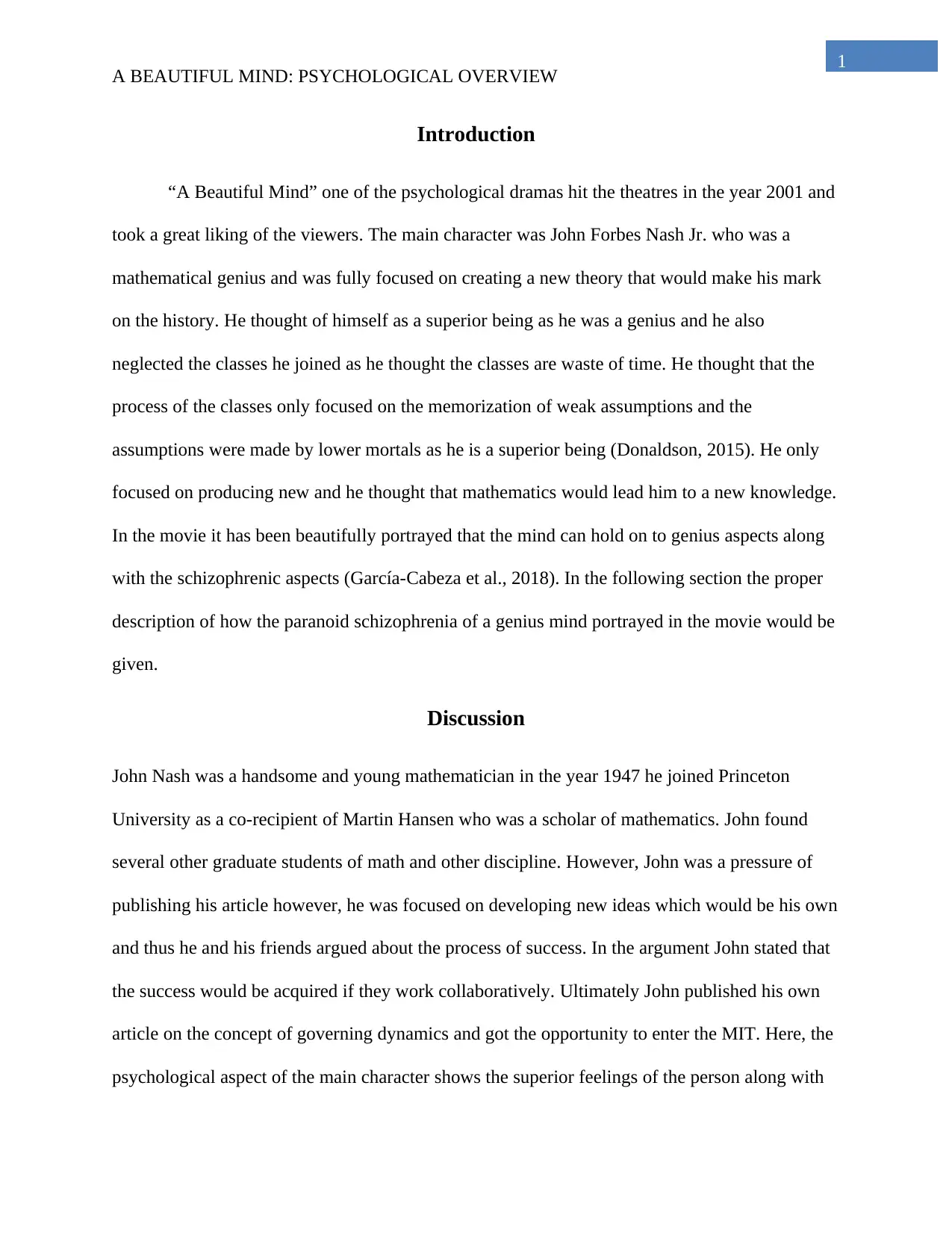
1
A BEAUTIFUL MIND: PSYCHOLOGICAL OVERVIEW
Introduction
“A Beautiful Mind” one of the psychological dramas hit the theatres in the year 2001 and
took a great liking of the viewers. The main character was John Forbes Nash Jr. who was a
mathematical genius and was fully focused on creating a new theory that would make his mark
on the history. He thought of himself as a superior being as he was a genius and he also
neglected the classes he joined as he thought the classes are waste of time. He thought that the
process of the classes only focused on the memorization of weak assumptions and the
assumptions were made by lower mortals as he is a superior being (Donaldson, 2015). He only
focused on producing new and he thought that mathematics would lead him to a new knowledge.
In the movie it has been beautifully portrayed that the mind can hold on to genius aspects along
with the schizophrenic aspects (García-Cabeza et al., 2018). In the following section the proper
description of how the paranoid schizophrenia of a genius mind portrayed in the movie would be
given.
Discussion
John Nash was a handsome and young mathematician in the year 1947 he joined Princeton
University as a co-recipient of Martin Hansen who was a scholar of mathematics. John found
several other graduate students of math and other discipline. However, John was a pressure of
publishing his article however, he was focused on developing new ideas which would be his own
and thus he and his friends argued about the process of success. In the argument John stated that
the success would be acquired if they work collaboratively. Ultimately John published his own
article on the concept of governing dynamics and got the opportunity to enter the MIT. Here, the
psychological aspect of the main character shows the superior feelings of the person along with
A BEAUTIFUL MIND: PSYCHOLOGICAL OVERVIEW
Introduction
“A Beautiful Mind” one of the psychological dramas hit the theatres in the year 2001 and
took a great liking of the viewers. The main character was John Forbes Nash Jr. who was a
mathematical genius and was fully focused on creating a new theory that would make his mark
on the history. He thought of himself as a superior being as he was a genius and he also
neglected the classes he joined as he thought the classes are waste of time. He thought that the
process of the classes only focused on the memorization of weak assumptions and the
assumptions were made by lower mortals as he is a superior being (Donaldson, 2015). He only
focused on producing new and he thought that mathematics would lead him to a new knowledge.
In the movie it has been beautifully portrayed that the mind can hold on to genius aspects along
with the schizophrenic aspects (García-Cabeza et al., 2018). In the following section the proper
description of how the paranoid schizophrenia of a genius mind portrayed in the movie would be
given.
Discussion
John Nash was a handsome and young mathematician in the year 1947 he joined Princeton
University as a co-recipient of Martin Hansen who was a scholar of mathematics. John found
several other graduate students of math and other discipline. However, John was a pressure of
publishing his article however, he was focused on developing new ideas which would be his own
and thus he and his friends argued about the process of success. In the argument John stated that
the success would be acquired if they work collaboratively. Ultimately John published his own
article on the concept of governing dynamics and got the opportunity to enter the MIT. Here, the
psychological aspect of the main character shows the superior feelings of the person along with
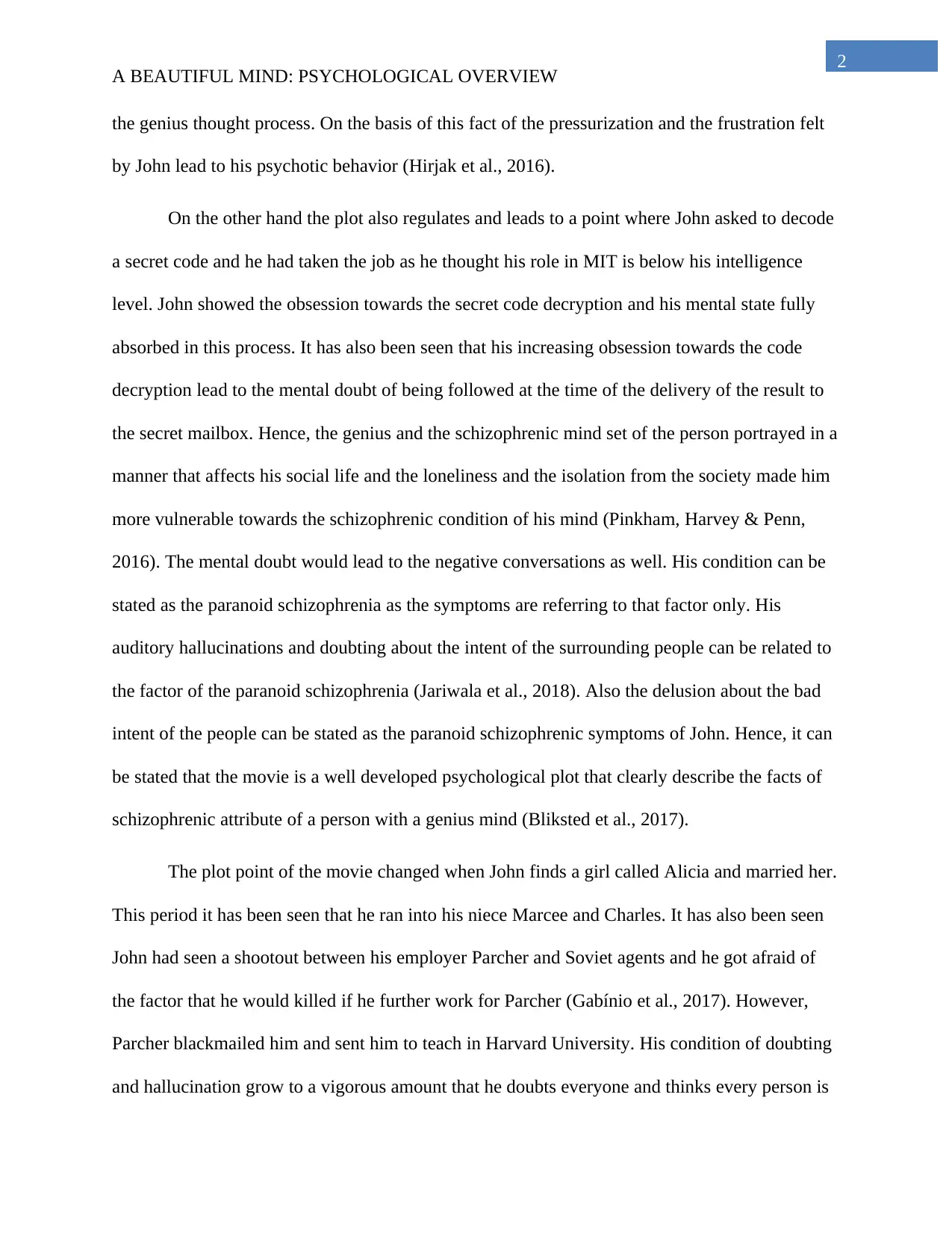
2
A BEAUTIFUL MIND: PSYCHOLOGICAL OVERVIEW
the genius thought process. On the basis of this fact of the pressurization and the frustration felt
by John lead to his psychotic behavior (Hirjak et al., 2016).
On the other hand the plot also regulates and leads to a point where John asked to decode
a secret code and he had taken the job as he thought his role in MIT is below his intelligence
level. John showed the obsession towards the secret code decryption and his mental state fully
absorbed in this process. It has also been seen that his increasing obsession towards the code
decryption lead to the mental doubt of being followed at the time of the delivery of the result to
the secret mailbox. Hence, the genius and the schizophrenic mind set of the person portrayed in a
manner that affects his social life and the loneliness and the isolation from the society made him
more vulnerable towards the schizophrenic condition of his mind (Pinkham, Harvey & Penn,
2016). The mental doubt would lead to the negative conversations as well. His condition can be
stated as the paranoid schizophrenia as the symptoms are referring to that factor only. His
auditory hallucinations and doubting about the intent of the surrounding people can be related to
the factor of the paranoid schizophrenia (Jariwala et al., 2018). Also the delusion about the bad
intent of the people can be stated as the paranoid schizophrenic symptoms of John. Hence, it can
be stated that the movie is a well developed psychological plot that clearly describe the facts of
schizophrenic attribute of a person with a genius mind (Bliksted et al., 2017).
The plot point of the movie changed when John finds a girl called Alicia and married her.
This period it has been seen that he ran into his niece Marcee and Charles. It has also been seen
John had seen a shootout between his employer Parcher and Soviet agents and he got afraid of
the factor that he would killed if he further work for Parcher (Gabínio et al., 2017). However,
Parcher blackmailed him and sent him to teach in Harvard University. His condition of doubting
and hallucination grow to a vigorous amount that he doubts everyone and thinks every person is
A BEAUTIFUL MIND: PSYCHOLOGICAL OVERVIEW
the genius thought process. On the basis of this fact of the pressurization and the frustration felt
by John lead to his psychotic behavior (Hirjak et al., 2016).
On the other hand the plot also regulates and leads to a point where John asked to decode
a secret code and he had taken the job as he thought his role in MIT is below his intelligence
level. John showed the obsession towards the secret code decryption and his mental state fully
absorbed in this process. It has also been seen that his increasing obsession towards the code
decryption lead to the mental doubt of being followed at the time of the delivery of the result to
the secret mailbox. Hence, the genius and the schizophrenic mind set of the person portrayed in a
manner that affects his social life and the loneliness and the isolation from the society made him
more vulnerable towards the schizophrenic condition of his mind (Pinkham, Harvey & Penn,
2016). The mental doubt would lead to the negative conversations as well. His condition can be
stated as the paranoid schizophrenia as the symptoms are referring to that factor only. His
auditory hallucinations and doubting about the intent of the surrounding people can be related to
the factor of the paranoid schizophrenia (Jariwala et al., 2018). Also the delusion about the bad
intent of the people can be stated as the paranoid schizophrenic symptoms of John. Hence, it can
be stated that the movie is a well developed psychological plot that clearly describe the facts of
schizophrenic attribute of a person with a genius mind (Bliksted et al., 2017).
The plot point of the movie changed when John finds a girl called Alicia and married her.
This period it has been seen that he ran into his niece Marcee and Charles. It has also been seen
John had seen a shootout between his employer Parcher and Soviet agents and he got afraid of
the factor that he would killed if he further work for Parcher (Gabínio et al., 2017). However,
Parcher blackmailed him and sent him to teach in Harvard University. His condition of doubting
and hallucination grow to a vigorous amount that he doubts everyone and thinks every person is
⊘ This is a preview!⊘
Do you want full access?
Subscribe today to unlock all pages.

Trusted by 1+ million students worldwide
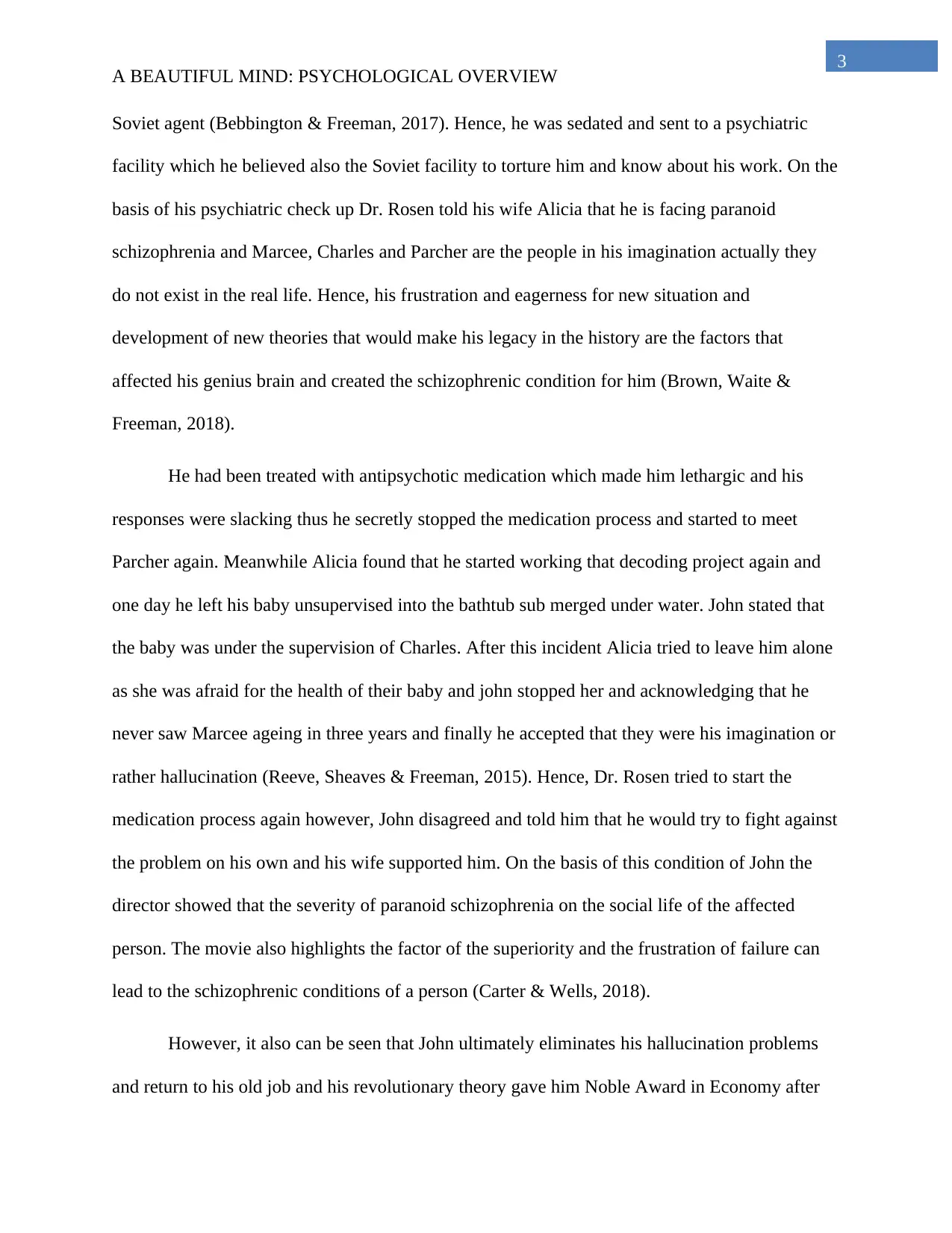
3
A BEAUTIFUL MIND: PSYCHOLOGICAL OVERVIEW
Soviet agent (Bebbington & Freeman, 2017). Hence, he was sedated and sent to a psychiatric
facility which he believed also the Soviet facility to torture him and know about his work. On the
basis of his psychiatric check up Dr. Rosen told his wife Alicia that he is facing paranoid
schizophrenia and Marcee, Charles and Parcher are the people in his imagination actually they
do not exist in the real life. Hence, his frustration and eagerness for new situation and
development of new theories that would make his legacy in the history are the factors that
affected his genius brain and created the schizophrenic condition for him (Brown, Waite &
Freeman, 2018).
He had been treated with antipsychotic medication which made him lethargic and his
responses were slacking thus he secretly stopped the medication process and started to meet
Parcher again. Meanwhile Alicia found that he started working that decoding project again and
one day he left his baby unsupervised into the bathtub sub merged under water. John stated that
the baby was under the supervision of Charles. After this incident Alicia tried to leave him alone
as she was afraid for the health of their baby and john stopped her and acknowledging that he
never saw Marcee ageing in three years and finally he accepted that they were his imagination or
rather hallucination (Reeve, Sheaves & Freeman, 2015). Hence, Dr. Rosen tried to start the
medication process again however, John disagreed and told him that he would try to fight against
the problem on his own and his wife supported him. On the basis of this condition of John the
director showed that the severity of paranoid schizophrenia on the social life of the affected
person. The movie also highlights the factor of the superiority and the frustration of failure can
lead to the schizophrenic conditions of a person (Carter & Wells, 2018).
However, it also can be seen that John ultimately eliminates his hallucination problems
and return to his old job and his revolutionary theory gave him Noble Award in Economy after
A BEAUTIFUL MIND: PSYCHOLOGICAL OVERVIEW
Soviet agent (Bebbington & Freeman, 2017). Hence, he was sedated and sent to a psychiatric
facility which he believed also the Soviet facility to torture him and know about his work. On the
basis of his psychiatric check up Dr. Rosen told his wife Alicia that he is facing paranoid
schizophrenia and Marcee, Charles and Parcher are the people in his imagination actually they
do not exist in the real life. Hence, his frustration and eagerness for new situation and
development of new theories that would make his legacy in the history are the factors that
affected his genius brain and created the schizophrenic condition for him (Brown, Waite &
Freeman, 2018).
He had been treated with antipsychotic medication which made him lethargic and his
responses were slacking thus he secretly stopped the medication process and started to meet
Parcher again. Meanwhile Alicia found that he started working that decoding project again and
one day he left his baby unsupervised into the bathtub sub merged under water. John stated that
the baby was under the supervision of Charles. After this incident Alicia tried to leave him alone
as she was afraid for the health of their baby and john stopped her and acknowledging that he
never saw Marcee ageing in three years and finally he accepted that they were his imagination or
rather hallucination (Reeve, Sheaves & Freeman, 2015). Hence, Dr. Rosen tried to start the
medication process again however, John disagreed and told him that he would try to fight against
the problem on his own and his wife supported him. On the basis of this condition of John the
director showed that the severity of paranoid schizophrenia on the social life of the affected
person. The movie also highlights the factor of the superiority and the frustration of failure can
lead to the schizophrenic conditions of a person (Carter & Wells, 2018).
However, it also can be seen that John ultimately eliminates his hallucination problems
and return to his old job and his revolutionary theory gave him Noble Award in Economy after
Paraphrase This Document
Need a fresh take? Get an instant paraphrase of this document with our AI Paraphraser
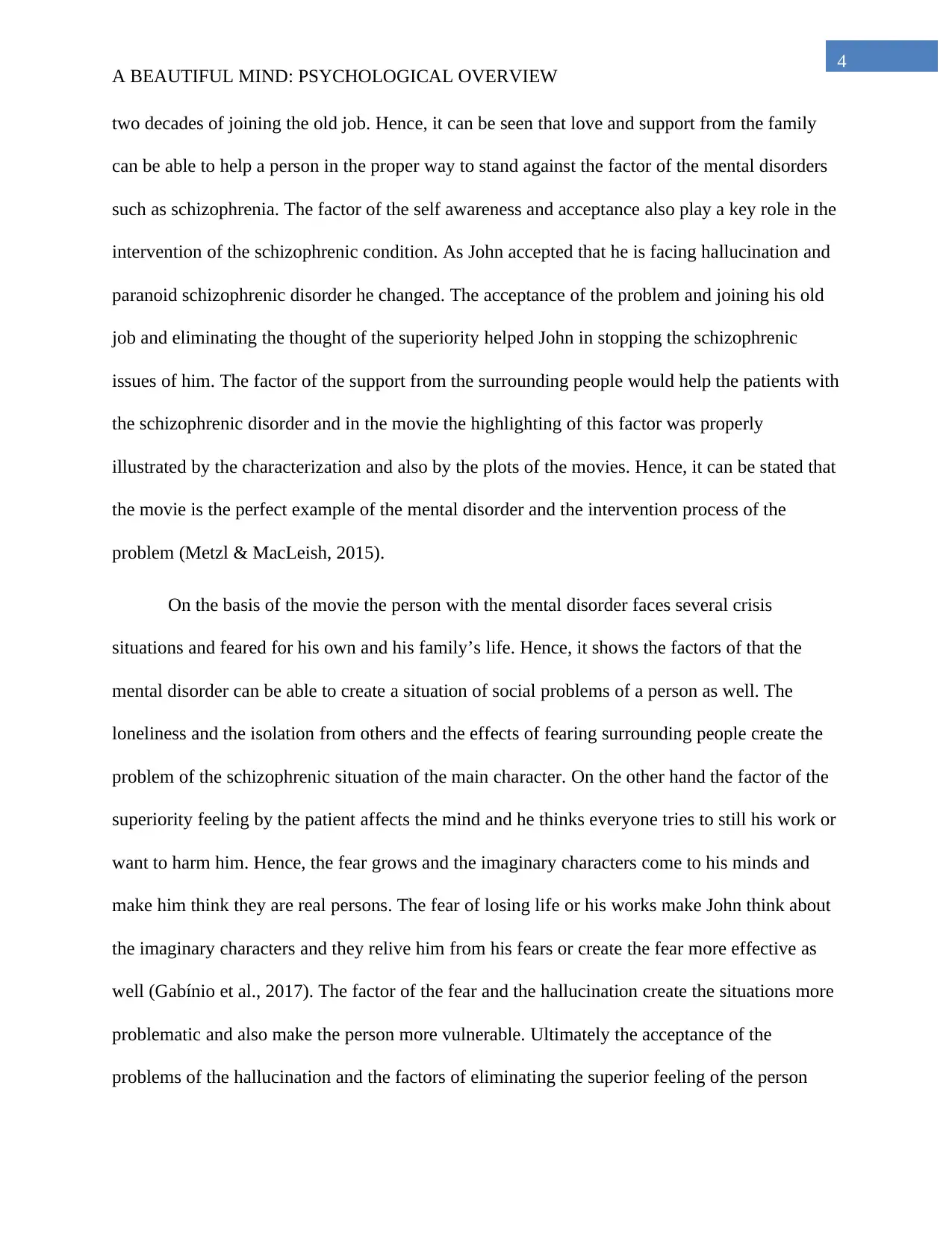
4
A BEAUTIFUL MIND: PSYCHOLOGICAL OVERVIEW
two decades of joining the old job. Hence, it can be seen that love and support from the family
can be able to help a person in the proper way to stand against the factor of the mental disorders
such as schizophrenia. The factor of the self awareness and acceptance also play a key role in the
intervention of the schizophrenic condition. As John accepted that he is facing hallucination and
paranoid schizophrenic disorder he changed. The acceptance of the problem and joining his old
job and eliminating the thought of the superiority helped John in stopping the schizophrenic
issues of him. The factor of the support from the surrounding people would help the patients with
the schizophrenic disorder and in the movie the highlighting of this factor was properly
illustrated by the characterization and also by the plots of the movies. Hence, it can be stated that
the movie is the perfect example of the mental disorder and the intervention process of the
problem (Metzl & MacLeish, 2015).
On the basis of the movie the person with the mental disorder faces several crisis
situations and feared for his own and his family’s life. Hence, it shows the factors of that the
mental disorder can be able to create a situation of social problems of a person as well. The
loneliness and the isolation from others and the effects of fearing surrounding people create the
problem of the schizophrenic situation of the main character. On the other hand the factor of the
superiority feeling by the patient affects the mind and he thinks everyone tries to still his work or
want to harm him. Hence, the fear grows and the imaginary characters come to his minds and
make him think they are real persons. The fear of losing life or his works make John think about
the imaginary characters and they relive him from his fears or create the fear more effective as
well (Gabínio et al., 2017). The factor of the fear and the hallucination create the situations more
problematic and also make the person more vulnerable. Ultimately the acceptance of the
problems of the hallucination and the factors of eliminating the superior feeling of the person
A BEAUTIFUL MIND: PSYCHOLOGICAL OVERVIEW
two decades of joining the old job. Hence, it can be seen that love and support from the family
can be able to help a person in the proper way to stand against the factor of the mental disorders
such as schizophrenia. The factor of the self awareness and acceptance also play a key role in the
intervention of the schizophrenic condition. As John accepted that he is facing hallucination and
paranoid schizophrenic disorder he changed. The acceptance of the problem and joining his old
job and eliminating the thought of the superiority helped John in stopping the schizophrenic
issues of him. The factor of the support from the surrounding people would help the patients with
the schizophrenic disorder and in the movie the highlighting of this factor was properly
illustrated by the characterization and also by the plots of the movies. Hence, it can be stated that
the movie is the perfect example of the mental disorder and the intervention process of the
problem (Metzl & MacLeish, 2015).
On the basis of the movie the person with the mental disorder faces several crisis
situations and feared for his own and his family’s life. Hence, it shows the factors of that the
mental disorder can be able to create a situation of social problems of a person as well. The
loneliness and the isolation from others and the effects of fearing surrounding people create the
problem of the schizophrenic situation of the main character. On the other hand the factor of the
superiority feeling by the patient affects the mind and he thinks everyone tries to still his work or
want to harm him. Hence, the fear grows and the imaginary characters come to his minds and
make him think they are real persons. The fear of losing life or his works make John think about
the imaginary characters and they relive him from his fears or create the fear more effective as
well (Gabínio et al., 2017). The factor of the fear and the hallucination create the situations more
problematic and also make the person more vulnerable. Ultimately the acceptance of the
problems of the hallucination and the factors of eliminating the superior feeling of the person
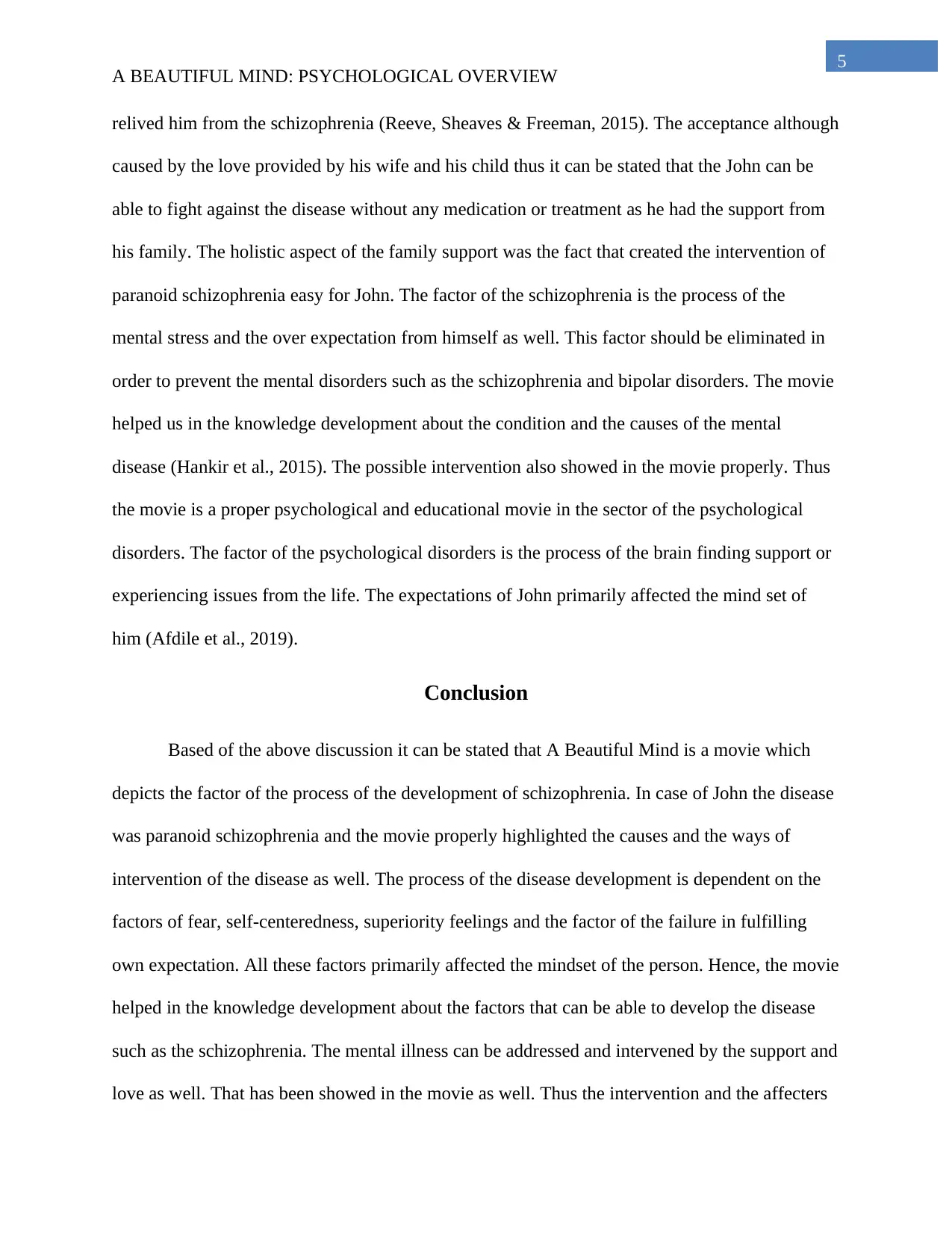
5
A BEAUTIFUL MIND: PSYCHOLOGICAL OVERVIEW
relived him from the schizophrenia (Reeve, Sheaves & Freeman, 2015). The acceptance although
caused by the love provided by his wife and his child thus it can be stated that the John can be
able to fight against the disease without any medication or treatment as he had the support from
his family. The holistic aspect of the family support was the fact that created the intervention of
paranoid schizophrenia easy for John. The factor of the schizophrenia is the process of the
mental stress and the over expectation from himself as well. This factor should be eliminated in
order to prevent the mental disorders such as the schizophrenia and bipolar disorders. The movie
helped us in the knowledge development about the condition and the causes of the mental
disease (Hankir et al., 2015). The possible intervention also showed in the movie properly. Thus
the movie is a proper psychological and educational movie in the sector of the psychological
disorders. The factor of the psychological disorders is the process of the brain finding support or
experiencing issues from the life. The expectations of John primarily affected the mind set of
him (Afdile et al., 2019).
Conclusion
Based of the above discussion it can be stated that A Beautiful Mind is a movie which
depicts the factor of the process of the development of schizophrenia. In case of John the disease
was paranoid schizophrenia and the movie properly highlighted the causes and the ways of
intervention of the disease as well. The process of the disease development is dependent on the
factors of fear, self-centeredness, superiority feelings and the factor of the failure in fulfilling
own expectation. All these factors primarily affected the mindset of the person. Hence, the movie
helped in the knowledge development about the factors that can be able to develop the disease
such as the schizophrenia. The mental illness can be addressed and intervened by the support and
love as well. That has been showed in the movie as well. Thus the intervention and the affecters
A BEAUTIFUL MIND: PSYCHOLOGICAL OVERVIEW
relived him from the schizophrenia (Reeve, Sheaves & Freeman, 2015). The acceptance although
caused by the love provided by his wife and his child thus it can be stated that the John can be
able to fight against the disease without any medication or treatment as he had the support from
his family. The holistic aspect of the family support was the fact that created the intervention of
paranoid schizophrenia easy for John. The factor of the schizophrenia is the process of the
mental stress and the over expectation from himself as well. This factor should be eliminated in
order to prevent the mental disorders such as the schizophrenia and bipolar disorders. The movie
helped us in the knowledge development about the condition and the causes of the mental
disease (Hankir et al., 2015). The possible intervention also showed in the movie properly. Thus
the movie is a proper psychological and educational movie in the sector of the psychological
disorders. The factor of the psychological disorders is the process of the brain finding support or
experiencing issues from the life. The expectations of John primarily affected the mind set of
him (Afdile et al., 2019).
Conclusion
Based of the above discussion it can be stated that A Beautiful Mind is a movie which
depicts the factor of the process of the development of schizophrenia. In case of John the disease
was paranoid schizophrenia and the movie properly highlighted the causes and the ways of
intervention of the disease as well. The process of the disease development is dependent on the
factors of fear, self-centeredness, superiority feelings and the factor of the failure in fulfilling
own expectation. All these factors primarily affected the mindset of the person. Hence, the movie
helped in the knowledge development about the factors that can be able to develop the disease
such as the schizophrenia. The mental illness can be addressed and intervened by the support and
love as well. That has been showed in the movie as well. Thus the intervention and the affecters
⊘ This is a preview!⊘
Do you want full access?
Subscribe today to unlock all pages.

Trusted by 1+ million students worldwide
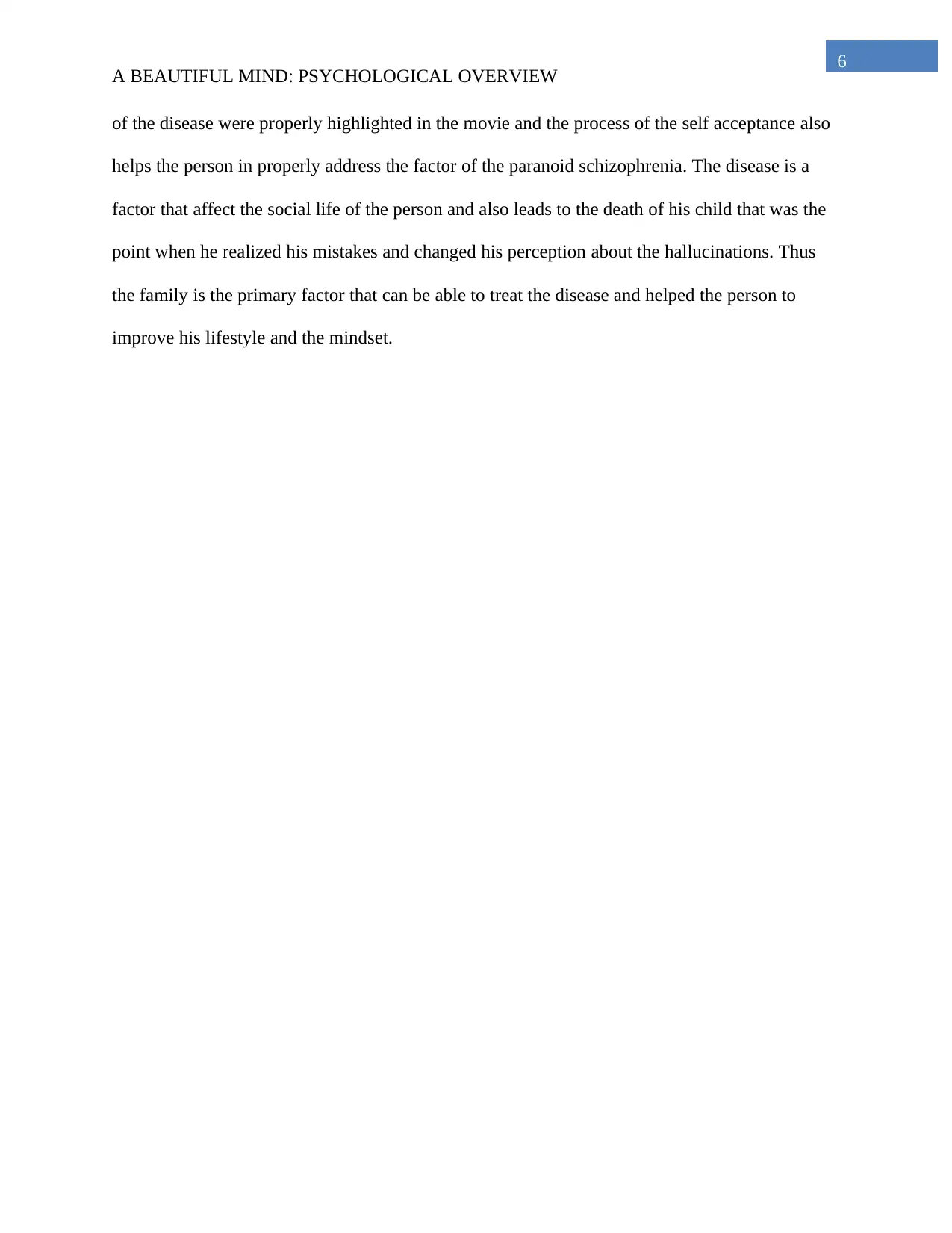
6
A BEAUTIFUL MIND: PSYCHOLOGICAL OVERVIEW
of the disease were properly highlighted in the movie and the process of the self acceptance also
helps the person in properly address the factor of the paranoid schizophrenia. The disease is a
factor that affect the social life of the person and also leads to the death of his child that was the
point when he realized his mistakes and changed his perception about the hallucinations. Thus
the family is the primary factor that can be able to treat the disease and helped the person to
improve his lifestyle and the mindset.
A BEAUTIFUL MIND: PSYCHOLOGICAL OVERVIEW
of the disease were properly highlighted in the movie and the process of the self acceptance also
helps the person in properly address the factor of the paranoid schizophrenia. The disease is a
factor that affect the social life of the person and also leads to the death of his child that was the
point when he realized his mistakes and changed his perception about the hallucinations. Thus
the family is the primary factor that can be able to treat the disease and helped the person to
improve his lifestyle and the mindset.
Paraphrase This Document
Need a fresh take? Get an instant paraphrase of this document with our AI Paraphraser
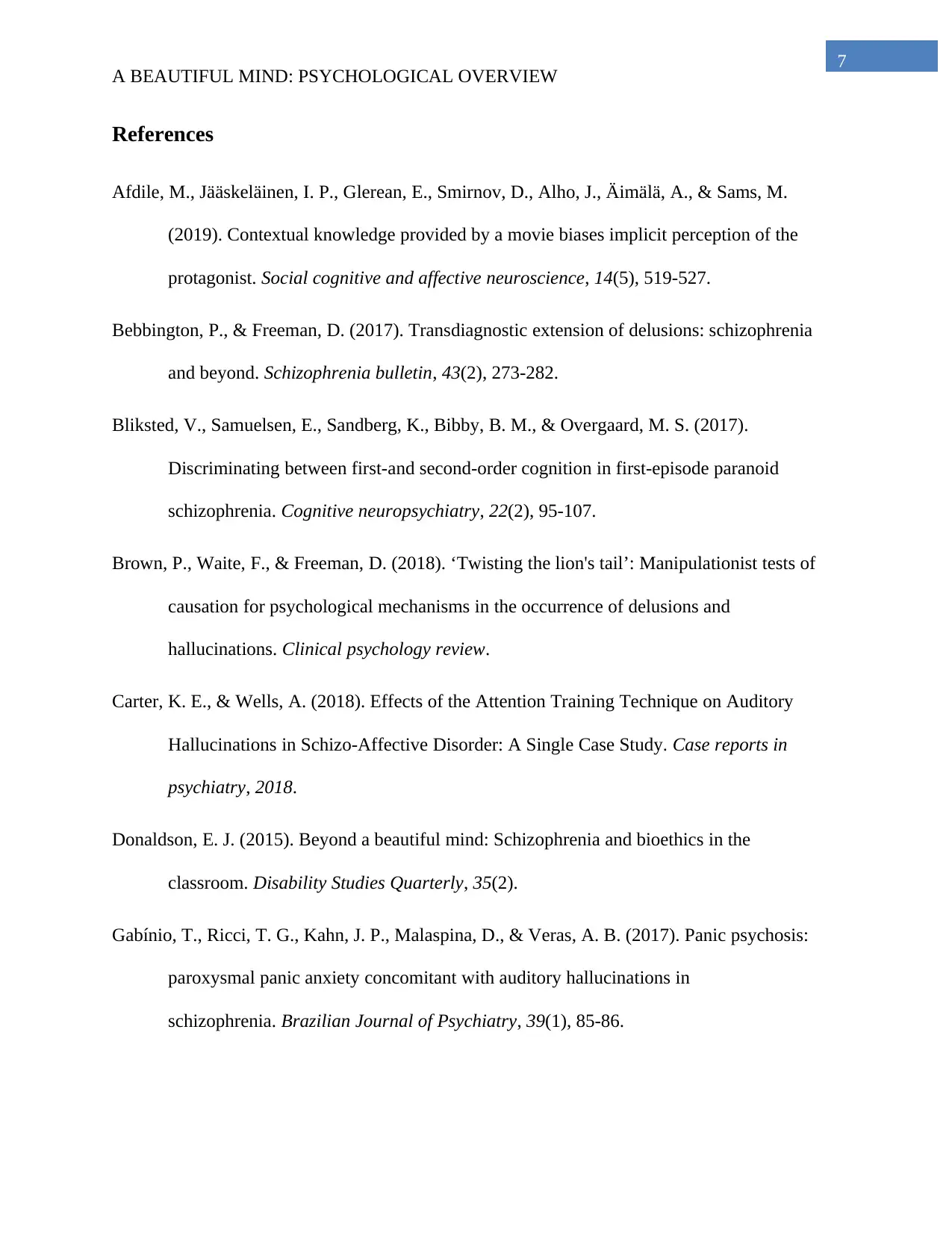
7
A BEAUTIFUL MIND: PSYCHOLOGICAL OVERVIEW
References
Afdile, M., Jääskeläinen, I. P., Glerean, E., Smirnov, D., Alho, J., Äimälä, A., & Sams, M.
(2019). Contextual knowledge provided by a movie biases implicit perception of the
protagonist. Social cognitive and affective neuroscience, 14(5), 519-527.
Bebbington, P., & Freeman, D. (2017). Transdiagnostic extension of delusions: schizophrenia
and beyond. Schizophrenia bulletin, 43(2), 273-282.
Bliksted, V., Samuelsen, E., Sandberg, K., Bibby, B. M., & Overgaard, M. S. (2017).
Discriminating between first-and second-order cognition in first-episode paranoid
schizophrenia. Cognitive neuropsychiatry, 22(2), 95-107.
Brown, P., Waite, F., & Freeman, D. (2018). ‘Twisting the lion's tail’: Manipulationist tests of
causation for psychological mechanisms in the occurrence of delusions and
hallucinations. Clinical psychology review.
Carter, K. E., & Wells, A. (2018). Effects of the Attention Training Technique on Auditory
Hallucinations in Schizo-Affective Disorder: A Single Case Study. Case reports in
psychiatry, 2018.
Donaldson, E. J. (2015). Beyond a beautiful mind: Schizophrenia and bioethics in the
classroom. Disability Studies Quarterly, 35(2).
Gabínio, T., Ricci, T. G., Kahn, J. P., Malaspina, D., & Veras, A. B. (2017). Panic psychosis:
paroxysmal panic anxiety concomitant with auditory hallucinations in
schizophrenia. Brazilian Journal of Psychiatry, 39(1), 85-86.
A BEAUTIFUL MIND: PSYCHOLOGICAL OVERVIEW
References
Afdile, M., Jääskeläinen, I. P., Glerean, E., Smirnov, D., Alho, J., Äimälä, A., & Sams, M.
(2019). Contextual knowledge provided by a movie biases implicit perception of the
protagonist. Social cognitive and affective neuroscience, 14(5), 519-527.
Bebbington, P., & Freeman, D. (2017). Transdiagnostic extension of delusions: schizophrenia
and beyond. Schizophrenia bulletin, 43(2), 273-282.
Bliksted, V., Samuelsen, E., Sandberg, K., Bibby, B. M., & Overgaard, M. S. (2017).
Discriminating between first-and second-order cognition in first-episode paranoid
schizophrenia. Cognitive neuropsychiatry, 22(2), 95-107.
Brown, P., Waite, F., & Freeman, D. (2018). ‘Twisting the lion's tail’: Manipulationist tests of
causation for psychological mechanisms in the occurrence of delusions and
hallucinations. Clinical psychology review.
Carter, K. E., & Wells, A. (2018). Effects of the Attention Training Technique on Auditory
Hallucinations in Schizo-Affective Disorder: A Single Case Study. Case reports in
psychiatry, 2018.
Donaldson, E. J. (2015). Beyond a beautiful mind: Schizophrenia and bioethics in the
classroom. Disability Studies Quarterly, 35(2).
Gabínio, T., Ricci, T. G., Kahn, J. P., Malaspina, D., & Veras, A. B. (2017). Panic psychosis:
paroxysmal panic anxiety concomitant with auditory hallucinations in
schizophrenia. Brazilian Journal of Psychiatry, 39(1), 85-86.
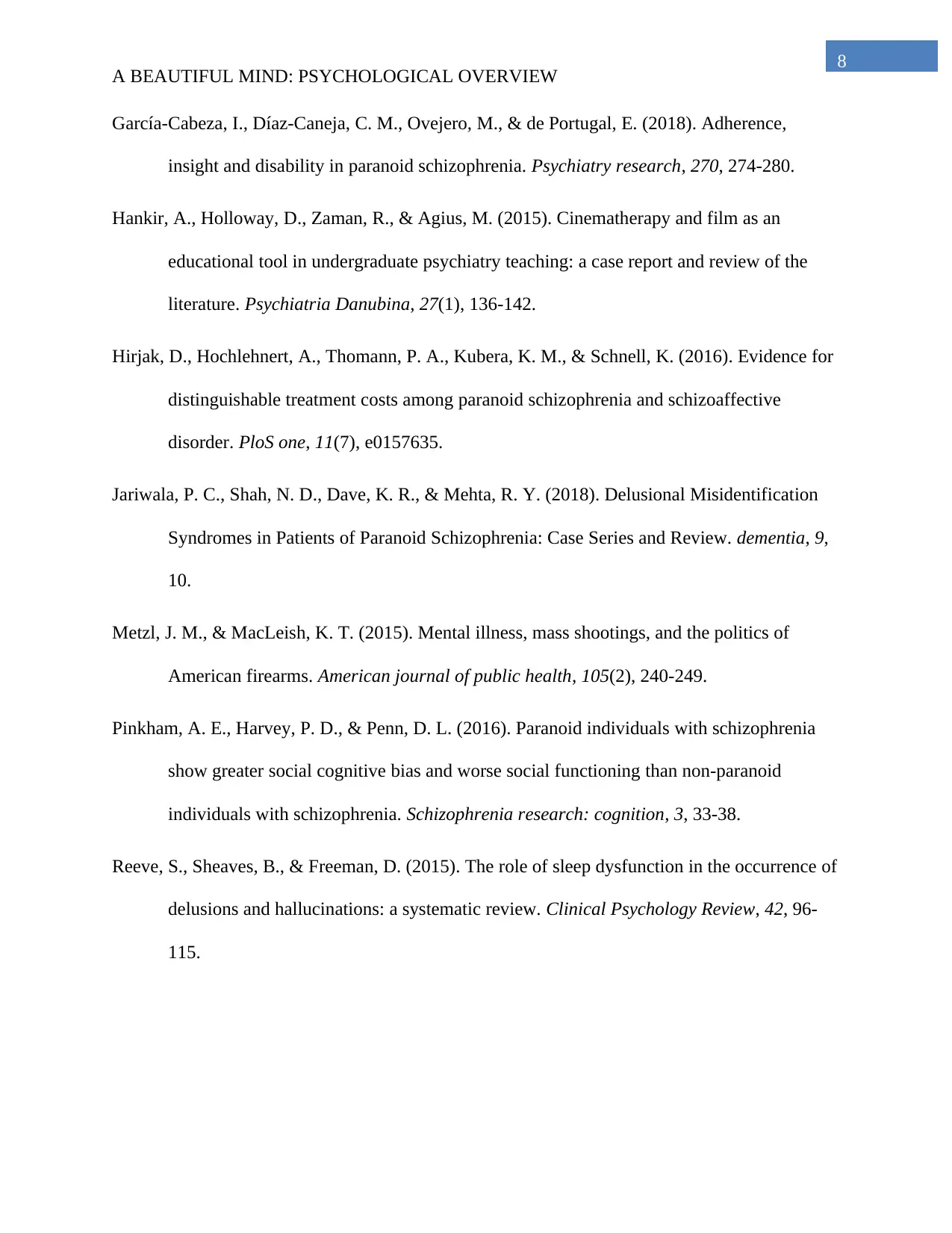
8
A BEAUTIFUL MIND: PSYCHOLOGICAL OVERVIEW
García-Cabeza, I., Díaz-Caneja, C. M., Ovejero, M., & de Portugal, E. (2018). Adherence,
insight and disability in paranoid schizophrenia. Psychiatry research, 270, 274-280.
Hankir, A., Holloway, D., Zaman, R., & Agius, M. (2015). Cinematherapy and film as an
educational tool in undergraduate psychiatry teaching: a case report and review of the
literature. Psychiatria Danubina, 27(1), 136-142.
Hirjak, D., Hochlehnert, A., Thomann, P. A., Kubera, K. M., & Schnell, K. (2016). Evidence for
distinguishable treatment costs among paranoid schizophrenia and schizoaffective
disorder. PloS one, 11(7), e0157635.
Jariwala, P. C., Shah, N. D., Dave, K. R., & Mehta, R. Y. (2018). Delusional Misidentification
Syndromes in Patients of Paranoid Schizophrenia: Case Series and Review. dementia, 9,
10.
Metzl, J. M., & MacLeish, K. T. (2015). Mental illness, mass shootings, and the politics of
American firearms. American journal of public health, 105(2), 240-249.
Pinkham, A. E., Harvey, P. D., & Penn, D. L. (2016). Paranoid individuals with schizophrenia
show greater social cognitive bias and worse social functioning than non-paranoid
individuals with schizophrenia. Schizophrenia research: cognition, 3, 33-38.
Reeve, S., Sheaves, B., & Freeman, D. (2015). The role of sleep dysfunction in the occurrence of
delusions and hallucinations: a systematic review. Clinical Psychology Review, 42, 96-
115.
A BEAUTIFUL MIND: PSYCHOLOGICAL OVERVIEW
García-Cabeza, I., Díaz-Caneja, C. M., Ovejero, M., & de Portugal, E. (2018). Adherence,
insight and disability in paranoid schizophrenia. Psychiatry research, 270, 274-280.
Hankir, A., Holloway, D., Zaman, R., & Agius, M. (2015). Cinematherapy and film as an
educational tool in undergraduate psychiatry teaching: a case report and review of the
literature. Psychiatria Danubina, 27(1), 136-142.
Hirjak, D., Hochlehnert, A., Thomann, P. A., Kubera, K. M., & Schnell, K. (2016). Evidence for
distinguishable treatment costs among paranoid schizophrenia and schizoaffective
disorder. PloS one, 11(7), e0157635.
Jariwala, P. C., Shah, N. D., Dave, K. R., & Mehta, R. Y. (2018). Delusional Misidentification
Syndromes in Patients of Paranoid Schizophrenia: Case Series and Review. dementia, 9,
10.
Metzl, J. M., & MacLeish, K. T. (2015). Mental illness, mass shootings, and the politics of
American firearms. American journal of public health, 105(2), 240-249.
Pinkham, A. E., Harvey, P. D., & Penn, D. L. (2016). Paranoid individuals with schizophrenia
show greater social cognitive bias and worse social functioning than non-paranoid
individuals with schizophrenia. Schizophrenia research: cognition, 3, 33-38.
Reeve, S., Sheaves, B., & Freeman, D. (2015). The role of sleep dysfunction in the occurrence of
delusions and hallucinations: a systematic review. Clinical Psychology Review, 42, 96-
115.
⊘ This is a preview!⊘
Do you want full access?
Subscribe today to unlock all pages.

Trusted by 1+ million students worldwide
1 out of 9
Related Documents
Your All-in-One AI-Powered Toolkit for Academic Success.
+13062052269
info@desklib.com
Available 24*7 on WhatsApp / Email
![[object Object]](/_next/static/media/star-bottom.7253800d.svg)
Unlock your academic potential
Copyright © 2020–2025 A2Z Services. All Rights Reserved. Developed and managed by ZUCOL.



